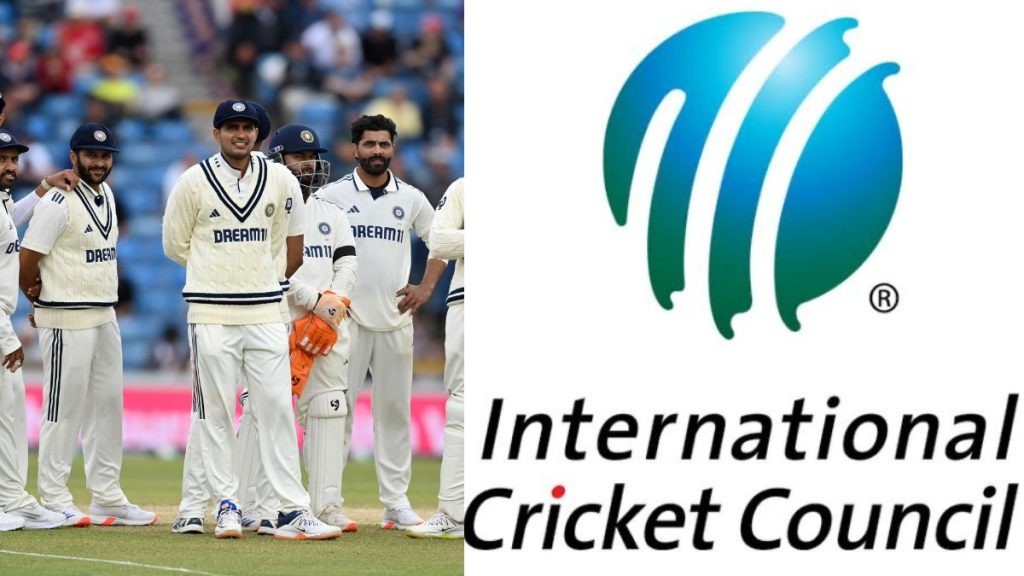The ICC has unveiled multiple new regulations and updated existing playing conditions across various formats. The changes pertaining to red-ball cricket are already in effect during the current WTC cycle, while those for white-ball cricket will take effect on July 2.
The International Cricket Council (ICC) has sanctioned a range of new playing conditions for men’s international cricket, affecting Tests, ODIs, and T20Is. Some adjustments have already been implemented in the ongoing 2025–27 World Test Championship (WTC) cycle, while white-ball updates will come into play from July 2. Here’s a summary of the key changes across formats:
Introduction of Stop Clock in Test Matches
The ICC has adopted the stop clock in Test cricket to tackle the slow over-rate issue, similar to its application in white-ball games. The fielding team must commence the next over within 60 seconds of the previous one finishing. If delays occur, umpires will issue two warnings before imposing a five-run penalty for further infractions. The clock resets every 80 overs and has already been enacted in the ongoing WTC cycle.
Relaxation of Saliva Rule and Ball Change Protocol
While the prohibition on using saliva to shine the ball continues, umpires are no longer obligated to change the ball immediately if saliva is found on it. This adjustment aims to deter teams from misusing saliva to force a ball change. The ball will now only be replaced if umpires determine its condition has significantly worsened. If deemed unaffected, the ball will remain in play, with the batting side still receiving a five-run penalty.
DRS to Review LBW after Overturned Catch Decisions
The ICC has updated the Decision Review System (DRS) for instances where a batter is initially given out caught and subsequently reviews the decision. If UltraEdge indicates no bat contact and the ball has struck the pad, the third umpire will now consider LBW, treating the original decision as “out.” Consequently, even if ball-tracking shows an “umpire’s call,” the batter will still be ruled out, a shift from the past approach.
Review Order Adjustment for Combined Appeals
In situations leading to multiple appeals, such as LBW coinciding with a run-out, the third umpire will assess them in the order they transpired. This changes the previous protocol that prioritized umpire-initiated reviews. Now, if a batter is dismissed on the first appeal, the ball is considered dead, and no review of the second appeal is permitted.
Catch Fairness Review Even with No-Ball Call
Under new rules, the third umpire must evaluate catch fairness even if the delivery is ruled a no-ball. If the catch is deemed fair, only the no-ball runs count toward the batting team’s score. However, if the catch is dropped, any runs scored by the batters will be included, ensuring fair outcomes for both teams.
Stricter Sanctions for Intentional Short Runs
The ICC has introduced heightened penalties for deliberate short runs, where a batter intentionally does not complete their run to deceive the fielding side. Alongside the existing five-run penalty, the fielding team can now select which batter will face the next delivery, while aborted runs will still be permissible if made without the intent to manipulate the officials.
Trial of Full-Time Injury Replacements in Domestic Cricket
The ICC has approved a trial for full-time player replacements in domestic first-class cricket. This rule allows teams to substitute a player who suffers a visible external injury—like a broken finger or facial injury—with an equivalent substitute. The substitute can participate fully in the match, differing from traditional replacements. This rule excludes muscle strains or internal injuries and will be trialed at the discretion of various cricket boards.
Return of One-Ball Rule in ODIs after 35 Overs
Starting July 2, ODIs will revert to utilizing a single ball from the 35th over onward. Previously, two balls were used from each end, which limited reverse swing and the ball’s wear. This adjustment aims to foster a better balance between bat and ball, enhancing the challenge for batters in the latter stages of innings.
Also Read:



